Remote Desktop Protocol (RDP) is a handy tool for accessing your computer from another location, but can you actually play games through an RDP connection? This question, which we’ll be diving into today here at SupremeDuelist.blog, is more complex than a simple yes or no. This article will explore the capabilities and limitations of gaming via RDP, examining how various factors impact your gaming experience and providing practical solutions to maximize performance.
We’ll break down the technical hurdles, explore potential pitfalls, and offer advice to those looking to game remotely. This comprehensive analysis should clarify whether playing games through RDP is a feasible option for you, and what steps you can take to optimize the experience. Let’s delve into the world of RDP gaming.
The Basics of RDP and How It Works
Before we discuss gaming specifically, let’s understand the fundamental nature of RDP. RDP allows you to control a computer remotely as if you were sitting in front of it. The remote computer processes everything, and the RDP client displays the result on your local device. Essentially, you’re not running the software locally; you are viewing a live stream of what’s happening on the remote machine. This process involves several steps:
- Initiating the connection: Your local device sends a request to connect to the remote computer via a network.
- Authentication: The remote computer verifies the user’s credentials.
- Display transfer: The remote computer sends screen updates (images, mouse movement, keystrokes) to the local device.
- Input transfer: The local device sends user input back to the remote machine.
 gaming through rdp connection
gaming through rdp connection
This process is typically optimized for tasks like office applications and file management, not graphically intensive applications like video games. The limitations of RDP will become clearer as we consider gaming scenarios.
Can You Play Games Through RDP? The Short Answer
Yes, you can technically play games through an RDP connection. However, the more pertinent question is: Should you? The reality is that the quality of the experience will heavily depend on the game itself, the network conditions, and the hardware involved. RDP wasn’t designed for high-framerate, low-latency gaming; it’s optimized for static screen changes and mouse clicks. This can cause issues that are not present in traditional gaming situations. For casual games or older titles, RDP might be tolerable but for fast-paced modern games, it often falls short.
Why RDP Isn’t Ideal for Gaming
Several factors hinder the seamless integration of RDP for gaming:
- Latency: The time it takes for your input to reach the remote machine and for the corresponding response to be displayed on your screen is called latency. RDP, by its nature, introduces latency. This can translate to input lag and delays that are detrimental to competitive or reflex-based gameplay.
- Bandwidth: Transferring high-resolution video with constant frame updates requires significant bandwidth. Insufficient bandwidth leads to pixelated graphics, stuttering, or disconnections.
- Limited Graphics Acceleration: RDP often lacks direct access to your graphics card. In many cases, the rendering is handled by the remote computer’s CPU and generic display drivers, rather than utilizing dedicated GPU hardware. This dramatically reduces the graphical fidelity and performance of your games.
- Sound Issues: Audio streaming via RDP isn’t always perfect. You may experience stutters, crackling sounds, or even a complete loss of audio, which can ruin immersion.
- Input Handling: Some games rely on low-level input hardware access that isn’t always compatible with the abstraction that RDP provides.
- Network Congestion: If your local network or the network of the remote computer is experiencing congestion, that will compound the problems.
These technical hurdles make gaming through RDP a frustrating experience for many users. “The inherent design of RDP isn’t geared for gaming,” states Dr. Anya Sharma, a computer networking specialist, “it was created for remote management not for real-time, graphically intensive applications. The latency and limited graphics acceleration are major drawbacks for gamers”.
What Types of Games Might Work with RDP?
While RDP isn’t ideal for all games, some titles are less demanding than others. Here are some types of games that might be playable through RDP:
- Older Games: Classic games from the 1990s or early 2000s often have much lower graphical requirements.
- Turn-Based Strategy Games: Games where quick reflexes are not essential can be surprisingly playable.
- 2D Indie Games: Many indie titles, especially those with 2D graphics, place less stress on the hardware.
- Simple Puzzle Games: Logic games and puzzles are generally less impacted by latency and graphical limitations.
- Text-Based Games: Games that rely mostly on text don’t require much in the way of graphical power.
However, don’t expect to smoothly play the latest AAA first-person shooters or high-fidelity racing games using a standard RDP setup.
Optimizing RDP for Gaming – Tips and Tricks
While not ideal, there are steps you can take to improve your RDP gaming experience:
- Use a fast network connection: Both your local and remote computers need fast, stable internet connections. Wired connections are always preferred to WiFi due to their lower latency.
- Adjust the display settings: Reduce the resolution of the remote desktop and color depth for better performance.
- Disable non-essential graphical elements: Windows Aero and other visual features can consume resources, so turning them off may reduce the load.
- Use GPU-Accelerated RDP: Ensure the RDP client you use supports hardware acceleration, which utilizes the power of the GPU to reduce CPU load and improve rendering. This can greatly enhance the experience if the server’s OS and GPU support it.
- Close unnecessary applications: Any background process on the remote machine can eat into resources and cause issues. Close any unnecessary programs before starting a game.
- Try alternative RDP software: Some third-party RDP clients offer more features and customizations geared toward enhancing performance, though results may vary.
- Adjust game graphics: Set graphics settings to the lowest level within the game itself.
 optimizing game settings for rdp
optimizing game settings for rdp
By tweaking these settings, you can sometimes make marginal improvements in RDP gaming.
Alternatives to RDP for Gaming
Given the limitations of RDP, several alternatives are available that are specifically designed for remote gaming:
- Cloud Gaming Services: Services like NVIDIA GeForce Now, Xbox Cloud Gaming, and PlayStation Plus offer game streaming directly from the cloud. They handle processing and graphics rendering remotely, and stream the gameplay to your device. This removes some of the hardware burdens on both computers.
- Steam Remote Play: Steam offers a built-in feature for streaming games from a computer running the Steam client to another computer or device, which is optimized for games. It allows for local play of games installed on a remote computer.
- Parsec: Parsec is a popular third-party application designed specifically for remote gaming. It offers low latency and good performance for various gaming needs, even high-performance ones.
- Dedicated Remote Desktop Gaming Software: Software such as Moonlight (an open-source client for NVIDIA GameStream) and Rainway are optimized for streaming games to remote clients.
These alternatives provide generally better gaming experiences than traditional RDP due to their optimizations for latency, graphics, and input.
Frequently Asked Questions About RDP Gaming
Can you play online multiplayer games through RDP?
Yes, you can, but the performance might suffer heavily due to increased input latency and bandwidth usage. Expect lag and potential disconnections, especially in fast-paced online games.
Is RDP good for playing graphically demanding games?
Generally, no. RDP struggles with graphically intense games due to its limitations on graphics acceleration and the latency involved in data transfer. You’ll likely encounter low frame rates and choppy graphics.
Can you use a controller with RDP gaming?
Yes, you can use a controller in many cases, but its performance will depend on the RDP client and network conditions.
Is RDP gaming secure?
While RDP can be encrypted, there are still security concerns. Make sure that you are using secure, up-to-date versions and are connecting through secure networks. Consider using a VPN.
What is the minimum internet speed for RDP gaming?
Ideally, a minimum of 20 Mbps upload and download speed is required for an acceptable experience, though higher bandwidth is always better. Lower speeds will severely impact image quality and cause significant latency.
Can RDP handle high-resolution gaming?
Not without considerable problems. High-resolution gaming demands a lot of bandwidth and processing power. RDP is more suited for lower resolutions to reduce system load. “RDP isn’t a replacement for local gaming”, according to James Chen, a gamer and freelance tech analyst, “but if you are creative and prepared, you can make it work for simpler games. The right software can make all the difference, especially for modern, fast paced games”.
Conclusion
While technically it is possible to play games through RDP connection, it’s often not the best solution for an enjoyable gaming experience. The limitations of latency, bandwidth, and graphics rendering make RDP generally unsuitable for anything other than simple games. For serious gaming, consider cloud gaming services, Steam Remote Play, or dedicated remote gaming software like Parsec. Always remember to assess your specific needs and network conditions to find the most suitable option. Stay tuned to SupremeDuelist.blog for more insights and tips on all things gaming. If you have further questions about remote gaming, leave a comment below. We’d love to hear your own experiences!
Leave a Reply